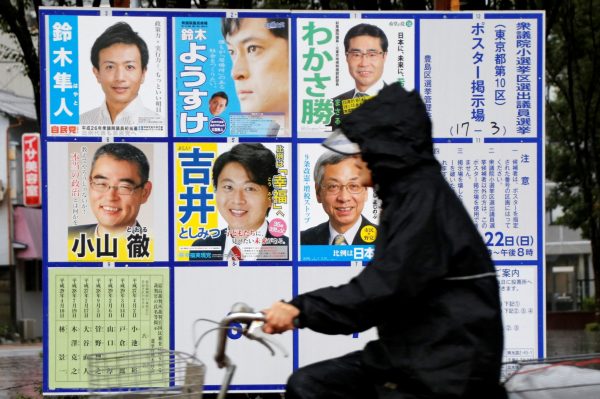He might also achieve his great ambition to revise the constitution before his self-imposed deadline of the 2020 Tokyo Olympics.
The LDP’s seeming electoral invincibility is not, however, a reflection of Abe’s popularity. Opinion polls before the election indicated that nearly half of all voters (47 per cent) would prefer to see Abe lose his prime ministership, while just over a third (37 per cent) wanted him to retain it. Voters were also sceptical about the timing of the election. Abe explained that he needed a renewed mandate on his firm stance against North Korea as well as his plan to divert future consumption tax revenue to education.
In reality the snap election was a self-serving and calculated gamble. It presented a window of opportunity for Abe to quash internal party challengers and win another three years as the LDP party president, up for re-election in September 2018. It was also a moment when the North Korean threat, including two missiles which flew over Japanese territory, produced a rally-behind-the-leader effect and Abe’s cabinet approval rating rebounded.
The opposition had requested an extraordinary session of the Diet — a prerogative which they are constitutionally guaranteed with the backing of a quarter of MPs in either house — in order to further interrogate Abe over the Moritomo Gakuen and Kake Gakuen scandals. They accuse Abe of using the snap election to avoid scrutiny.
The timing of the election also appeared to be designed to catch Japan’s opposition parties off guard. The LDP’s heavy loss in the Tokyo Metropolitan Assembly election in July to Tokyo Governor Yuriko Koike’s upstart regional party Tomin First No Kai (Tokyoites First), served as a warning to Abe that such a loss could be replicated at the national level. With Koike preparing the groundwork to go national, it seemed better for Abe to take her on now rather than later.
For a moment it looked as if Abe’s gamble might backfire. Just as Abe dissolved the lower house and called the election, Koike stole the limelight with the announcement of her national level Party of Hope. As Kuniaki Nemoto explains in our lead essay this week, ‘the new party attracted significant media attention as 14 Diet members, including Democratic Party (DP) converts and even an incumbent vice minister from the LDP, defected to join Hope’.
‘In a still more dramatic move a few days later, DP leader Maehara formed an agreement with Koike that all DP members would run under the Hope banner, meaning that the DP would eventually disband. As the new leader of the soon-to-disappear DP explained, he “would do anything” to topple the Abe administration’. With the DP’s numbers and cash for campaigning and Koike’s popular appeal, it appeared the LDP might for once have to face off against a political party in its own weight class.
But as quickly as the hype surrounding Koike’s Hope emerged, it dissipated. Koike refused to resign as Tokyo governor and run herself, and failed to nominate a parliamentary leader in her absence. ‘This left Hope without a prime ministerial candidate, confusing voters who want(ed) a clear alternative to Abe’. Koike was also unwilling to accept a simple merger with the DP. Keen to avoid the infighting which had characterized the DP, Koike ‘sought to admit only ideologically compatible members into her party’, screening out those MPs with different views on national security.
‘True to her reputation as a micromanager’, Corey Wallace explains, ‘Koike appeared overzealous in policing the ideological commitments of potential recruits from the Democratic Party. This drove those who rejected her “dictatorial” management style to set up their own party, the Constitutional Democratic Party of Japan (CDPJ)’. The CDPJ and its leader, Yukio Edano, quickly found strong grassroots support.
As Nemoto concludes, the end result was that ‘in as many as 208 of the 289 single-member districts, voters were split between three choices — the LDP–Komeito coalition, the conservative-right opposition (Hope and the Osaka-based regional party Ishin No Kai) and the liberal–left opposition (CDPJ, [the Japan Communist Party] and [the Social Democratic Party]) — which served to divide the anti-LDP vote’.
What does this portend for Japan’s long search for contestable party politics?
The DP never presented voters with a clear ideological position. Its factional infighting meant it never resolved whether it was a conservative party offering moderate alternatives to the LDP or a progressive party on the opposite side of the ideological divide. The split of the DP into Hope and the CDPJ now makes each party’s position and platform clearer.
‘The CDPJ’, Aurelia George Mulgan argues, ‘has the biggest potential for becoming the leading, mainstream opposition party to the LDP’. Because ‘it offers a solid platform of centre-left policies — particularly on security and constitutional issues’ it has the opportunity to cultivate its position as ‘the real opposition to the LDP’.
Koike and her Party of Hope may have a hard road ahead in distinguishing itself from the LDP given ideological similarities. Its populist stances against nuclear energy and tax increases will need to be backed up by tangible policy reform in Tokyo and a successful 2020 Olympics if Koike is to continue to expand her Hope project.
As the dust settles on the election, Japan’s party system will likely continue to be in flux for some time yet. But we should expect some fierce battles ahead and some form of consolidation among Japanese opposition groups in the lead up to the 2019 upper house election and the 2020 Olympics, especially as the Abe government moves to revise Japan’s constitution and its Article 9 peace clause.
The EAF Editorial Board is comprised of Peter Drysdale, Shiro Armstrong, Ben Ascione, Amy King, Liam Gammon, Jillian Mowbray-Tsutsumi and Ben Hillman, and is located in the Crawford School of Public Policy in the ANU College of Asia and the Pacific.

